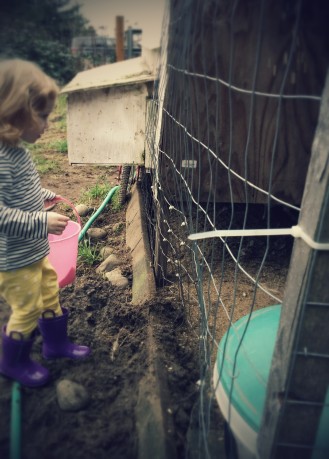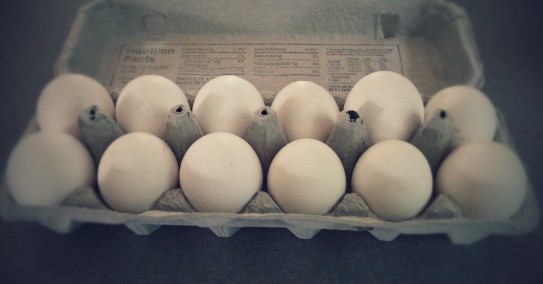When you hear the words Fruit Loop, what comes to mind? For me, it is that sugary sweet bowl of breakfast cereal from my childhood. That box that would show up on special occasions or when you were able to convince your mom that you needed a break from the Puffed Rice. It was pure heaven! The reality of the Fruit Loop that I experienced for my fieldtrip was even better than the memory of that sweet cereal from my childhood. The Hood River County Fruit Loop in Oregon is a sweet treat along the Columbia River. 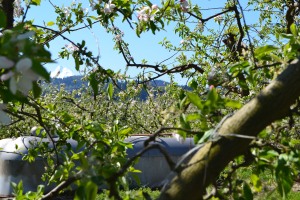 Hood River is quaint little town about a half an hour outside of Portland. It has spectacular views of Mt. Hood and the Columbia River. One of the best parts of visiting Hood River are the orchards and vineyards that line the hills as you make your way up the hill toward the mountain. Rows upon rows of apple, pear, peach and nut trees. Blueberries, raspberries, grapes, and lavender. All cover the hills. The Fruit Loop Tour is a showcase of the bounty found in Hood River.
Hood River is quaint little town about a half an hour outside of Portland. It has spectacular views of Mt. Hood and the Columbia River. One of the best parts of visiting Hood River are the orchards and vineyards that line the hills as you make your way up the hill toward the mountain. Rows upon rows of apple, pear, peach and nut trees. Blueberries, raspberries, grapes, and lavender. All cover the hills. The Fruit Loop Tour is a showcase of the bounty found in Hood River.
The Hood River County Fruit Loop was organized back in 1992. It was the concept of Kaye White, the owner of River Bend Farm and County Store. She modeled her idea around Apple Hill, which is located an hour outside of Sacramento. Like Apple Hill, Hood River County was an agricultural community looking to preserve their heritage and boost revenue. The Hood River County Fruit Loop was born.  The first Hood River Farmer’s Market and the first Fruit Loop map were printed through funds obtained by an agricultural grant, subsequent maps have been funded by the Hood River Chamber of Commerce Visitor Council.
The first Hood River Farmer’s Market and the first Fruit Loop map were printed through funds obtained by an agricultural grant, subsequent maps have been funded by the Hood River Chamber of Commerce Visitor Council.
There are 31 participating farms and vineyards on the 2015 Hood River County Fruit Loop. Most of the farms included on the Loop are family run farms. The owners of the farms are required to apply for membership and must meet certain criteria in order to be involved and put on the map. The Fruit Loop has a steering committee that the members select, but each farm is run independently. Each year the farms involved in the 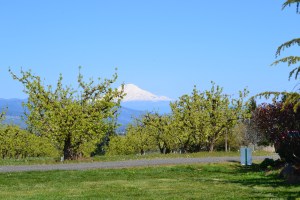 Fruit Loop must sign a contract that they agree to certain things. Some of the rules they must follow are following state and federal regulations, cleanliness, promoting other members of the Fruit Loop, and maintaining their stated hours. The Fruit Loop brings in thousands of visitors each year, which brings money into the county. The local shops, restaurants and hotels benefit from the influx of people brought to the area by this local treasure.
Fruit Loop must sign a contract that they agree to certain things. Some of the rules they must follow are following state and federal regulations, cleanliness, promoting other members of the Fruit Loop, and maintaining their stated hours. The Fruit Loop brings in thousands of visitors each year, which brings money into the county. The local shops, restaurants and hotels benefit from the influx of people brought to the area by this local treasure.
The busiest time of the year are the weekends of July through October. This is the time when the fruit is ready to pick.  There are events all year long that still bring visitors to the area. I went on the tour in April and there was still a lot to see. Many of the fruit trees were in bloom. There was also a Blossom Festival that was being held at the county fairground. Some of the events that draw visitors to the orchards are the Blossom Festival in April, the Cherry Celebration in July, the Lavender DAZE Festival in July, the Summer Fruit Celebration in August, Pear, Peach and Apple Celebrations in September and October. All these events are a treat for visitors and help to promote the local farmers of Hood River County.
There are events all year long that still bring visitors to the area. I went on the tour in April and there was still a lot to see. Many of the fruit trees were in bloom. There was also a Blossom Festival that was being held at the county fairground. Some of the events that draw visitors to the orchards are the Blossom Festival in April, the Cherry Celebration in July, the Lavender DAZE Festival in July, the Summer Fruit Celebration in August, Pear, Peach and Apple Celebrations in September and October. All these events are a treat for visitors and help to promote the local farmers of Hood River County.
The Fruit Loop is a thirty-five mile loop through scenic Hood River Valley. There are many fruit stands, vineyards and U-Pick Farms. All of the stops offer a true farm experience. Many places you can actually go out into the fields and pick your produce right from the tree. It is farm-to-table in the most authentic sense of the word. You can pick pears off the tree for lunch, gather a relaxing bouquet of lavender for your house, and then make a stop at the Alpaca farm to pick up some yarn for your next knitting project. It is “…thirty-five miles of orchards, farmlands and friendly communities” (Fruit Loop map).
You can pick pears off the tree for lunch, gather a relaxing bouquet of lavender for your house, and then make a stop at the Alpaca farm to pick up some yarn for your next knitting project. It is “…thirty-five miles of orchards, farmlands and friendly communities” (Fruit Loop map).
I had a wonderful day exploring the local farms and taking in the beautiful blossoms. Some of my favorites were:
Hood River Lavender Farms (www.hoodriverlavender.com): This is a little oasis in the middle of the orchards. The U-Pick Farm opens in May. They grow their own lavender, but also distill it to make a variety of lavender product that they sell. 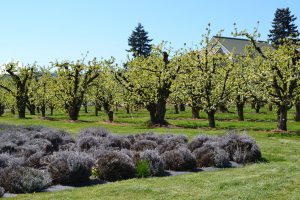 The little shop that they have on the property was heavenly. I walked in and immediately relaxed from the lavender scent. This organic farm is an example of what the Hood River has to offer.
The little shop that they have on the property was heavenly. I walked in and immediately relaxed from the lavender scent. This organic farm is an example of what the Hood River has to offer.
Draper Girls Country Farm & U-Pick Orchards (www.drapergirlscountryfarm.com): It is a family run farm that is open all year long. The U-Pick opens up in June and you are able to pick cherries, apples, pears, strawberries, raspberries,  blueberries, prunes, peaches and nectarines. Along with the U-Pick, they also have a farm stand and a farmer’s market. It is a fun farm experience.
blueberries, prunes, peaches and nectarines. Along with the U-Pick, they also have a farm stand and a farmer’s market. It is a fun farm experience.
Apple Valley Country Store & Bakery (applevalleystore.com): This old building was purchased by Bob and Kaye White in 1989 to serve as way to sell the produce that they grew on their farm. It has grown into a thriving business that specializes in jams, syrups and pie fillings among other products. It sponsored the Blossom Festival and Country BBQ that was going on when I was there.
The Hood River County Fruit Loop did not disappoint. 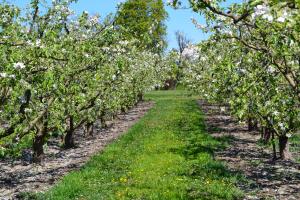 All my senses were happy. The panoramic views were stunning. The smell of lavender and fresh blossoms was intoxicating. The samples were delicious. I really enjoyed being able to take part in this farm experience. It was the perfect example of agriculture and tourism coming together to create a symbiotic relationship that benefits visitors and farmers alike.
All my senses were happy. The panoramic views were stunning. The smell of lavender and fresh blossoms was intoxicating. The samples were delicious. I really enjoyed being able to take part in this farm experience. It was the perfect example of agriculture and tourism coming together to create a symbiotic relationship that benefits visitors and farmers alike.
References:
hoodriverfruitloop.com. Hood River County Fruit Loop. 2015. Web. 24 April 2015.
applevalleystore.com. Apple Valley Country Store. 2012. Web. 24 April 2015.
hoodriverlavender.com. Hood River Lavender. 2015. Web. 24 April 2015.
Drapergirlscountryfarm.com. Draper Girls Country Farm. 2015. Web. 24 April 2015.
Godfrey, Jean. Email correspondence. 21 April 2015.

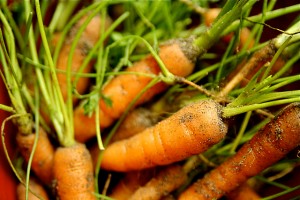

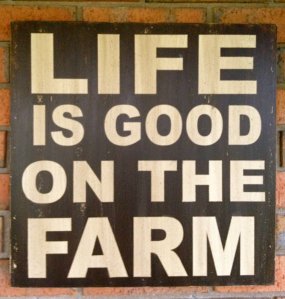


 This tradition that was passed down from grandfather to grandson, now is passed along to our children. It is a fun part of the process of planting our garden each year. This one aspect of farm culture has been passed down to our children and is a part of our family tapestry. We will never take steer manure for granted in our family. This farm tradition is a part of our family’s folklore.
This tradition that was passed down from grandfather to grandson, now is passed along to our children. It is a fun part of the process of planting our garden each year. This one aspect of farm culture has been passed down to our children and is a part of our family tapestry. We will never take steer manure for granted in our family. This farm tradition is a part of our family’s folklore.

 eggs about once a month.
eggs about once a month.